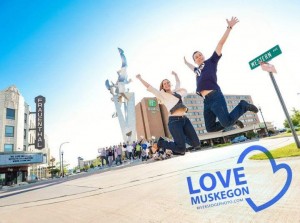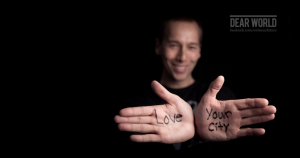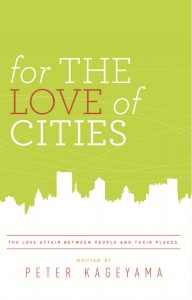Share This
Related Posts
Tags
Sharing the Love
By Leah Etling on Apr 2, 2013 in People
 Have you ever thought about what it would take to get your residents to not just like, but love, where they live?
Have you ever thought about what it would take to get your residents to not just like, but love, where they live?
Meet Peter Kageyama. He’s an expert on community engagement and the emotional power of place. That means that he has great ideas about how to make cities and spaces more interesting, create deeper personal connections between people and place, and understand our complicated relationships with where we live.
Author of a book called “For the Love of Cities” and co-founder of the Creative Cities Summit, Kageyama travels the country as a consultant, facilitating conversations between city leaders and citizens that often result in fun, simple, clever community projects. The sorts of efforts he encourages are grassroots, don’t cost much money, don’t require building or event permits, and yet often leave lasting impacts.
A native of Ohio and former attorney who found his real passion was a much more creative calling, Kageyama is a dynamic speaker and dedicated observer of unique urban details. Since his book came out, he has visited 50 cities around the country, where he listens to people talk about what makes their community an exceptional place to reside.
makes their community an exceptional place to reside.
“I get to see them the way the people who love them do, to look through the lens through which they see their city. It’s very much a blessing,” he said of his travels and consulting experiences.
The types of projects that Kageyama sees as effective affection-builders aren’t the sorts of things that you might expect from a long term community plan or a visioning summit. Some of them might seem totally off the wall. One of the cities he’s played a role in helping is Muskegon, Michigan, where the Love Muskegon campaign has created a viral iconic symbol that can be spotted all over town, a new ritual in which people toast the sunset over Lake Michigan, and even random civic boosters in green bodysuits and masks who show up at community events (yes, really).
“They don’t talk, they just want to make people smile and say ‘We love Muskegon’ and do something kind of cool – it’s genius,” Kageyama said of the masked green men.
Other ideas include pop-up art, performance, retail and food carts, street chalking, painting colorful murals on boring buildings, temporary seating in vacant lots or unused parking lots, a creative slogan of affection for the city that could be printed on bumper stickers or t-shirts, and many more. The only limits to creativity are a communities’ collective imaginations – and willingness to pitch in to make something happen.
“It turns out that there’s a pretty big gap between having an emotional connection to a place and doing something for the place. That’s one thing I emphasize in all the work that I do and all the cities that I go to – how you traverse that gap,” Kageyama said.
For multifamily managers, that’s a reality that likely rings true. You may know that your residents love living in their hometown – and at your apartment community. Perhaps they tell you every time you see them around the complex or in the front office. But translating that love of their home to a Like for your Facebook page, positive review on Yelp or ApartmentRatings, or attendance at a resident mixer may still be difficult.
Buying into a community-wide engagement effort can be one way to foster resident affection, both for your community and your city. Kageyama encourages multifamily developers and managers to participate i n community visioning efforts, even without a pending development project. And if you are in the planning or construction process, engaging the community before lease-up is ongoing can be a great way to build goodwill and excitement about the forthcoming new apartments.
n community visioning efforts, even without a pending development project. And if you are in the planning or construction process, engaging the community before lease-up is ongoing can be a great way to build goodwill and excitement about the forthcoming new apartments.
“I’m trying to get people to maintain that level of excitement and engagement and enthusiasm in a project, right now, and for the foreseeable future. What I would say to developers: While you’re taking care of that big stuff, what are the little things you could be doing that continue to keep people engaged and amused and interested in your project? Those things don’t have to cost a lot of money. But if you really were to have that citizen engagement, it doesn’t just happen at the charrette level, and then at the grand opening. There’s a pretty big gap between those two things, and you need to figure out how to fill that space.”
And it doesn’t have to be men in green suits, but think creatively about how you could encourage people to visit – or simply notice – the site of your new community before and while it is being built. Is there space out of the construction zone that you could donate for a community-wide usage? Perhaps food trucks that come to sell lunch to the construction crew might also find regular customers from neighboring businesses. What about adorning the construction fences with locally-inspired murals created by local schoolkids – whose parents might stop by to see the artwork, and become future apartment residents?
The opportunities to engage and inspire your community are endless. What creative strategies have you implemented?
